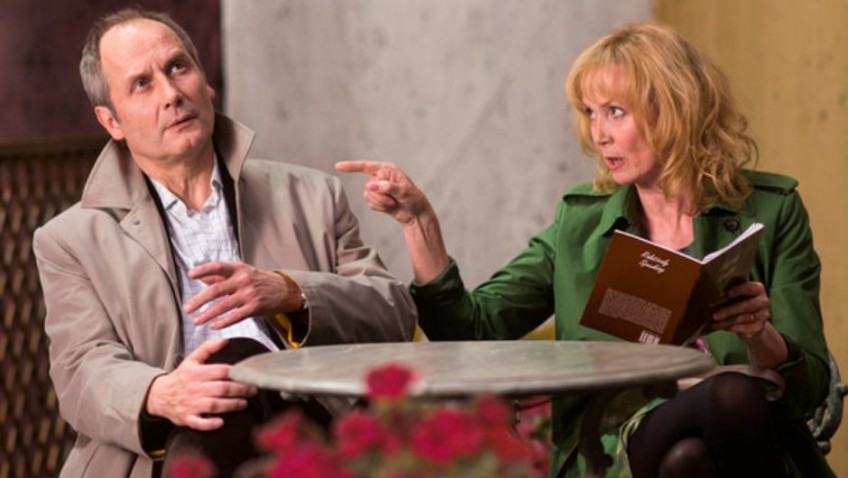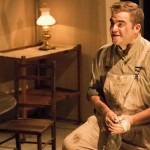In the final quarter of his career the French New Wave Writer/Director Alain Resnais (Last Year at Marienbad, The War is Over Hiroshima, Mon Amour) began frequenting Alan Ayckbourn’s theatre in Scarborough. Eventually, he struck up a personal and professional relationship with the British playwright of some wonderful theatrical farce. This period was also marked by his second marriage, to actress Sabine Azéma, (now 65) in 1998. Interestingly, they married in Scarborough and Azéma appeared in almost all of his films from that date, including Renais’ final film, The Life of Riley, which is being released posthumously in the UK.
Renais’ Smoking/No Smoking and Coeurs, based on the Ayckbourn plays Intimate Exchanges and Private Fear in Public Places respectively, were distinguished by their surreal touches, wit, and the intentionally the distancing theatricality of the sets and the filming style. The French press and public loved it, but the British and American reception to these works is very mixed.
When Renais was 90 he turned to Ayckbourn once again for The Life of Riley, which just goes to show that ‘retirement age’ is a relative term.
The English title refers to Ayckbourn’s conceit of an absent eponymous character who influences the lives of the characters: at first dividing them, only to bring them together again in a closer, more honest relationship. The French title, Aimer, Boire et Chanter (literally, To Love, To Drink and To Sing) is the title of a Johann Strauss II waltz that is heard during some of the film’s ‘scene’ transitions. But it also expresses, in a manner shared by Resnais himself, the optimistic mood of hope, playfulness and love that was with the eponymous George Riley faced death.
Set in a Yorkshire village, three couples who take their respective partners for granted after years of cohabitation, react to the news that their mutual friend George Riley has only months to live. They think of ways to help him, one being inclusion in a drama society they belong to. Rehearsals only serve to bring up memories that create rifts amongst the characters. George, who is now a bachelor and young at heart, decides that the play’s not the thing, but a trip to Tenerife is.
Each of the women (played by Sabine Azéma, Caroline Silhol and Sandrine Kiberlain as George’s ex-wife Monica) want to accompany him on this exotic trip, claiming he invited them along. When the men (Hippolyte Giradot, Michel Vuillermoz and André Dussollier) realise they are jealous their marriages and true feelings for one another are tested. In the end, the chosen woman comes as a surprise to the three couples, and to the audience, and serves as a reality check.
With all the good will in the world, it takes a long time to get into the film, and at times it feels more tedious than enjoyable. Though apparently light-hearted, the plot, the amateur drama we hear a couple rehearsing, the very artificial sets, and the fact that the characters speak in French, despite the English setting and props, suggest that we are all alienated from one another, or grow that way, perhaps because we paint an artificial picture of one another that is not accurate. We do not see Riley and most of the action, takes place off camera (or off stage). While all of this alienation might be making a statement about the human condition, it might also alienate the viewer.
Resnais has fun playing with the differences between the stock-in-trade techniques of film and theatre, although even if you appreciate the wit, you might feel it amuses Renais more than his audience. Resnais uses the standard ‘establishing shot’ taught at film school, but here it is a simplistic cartoon of the home of the character(s) who soon appear.
The same location is then represented one-dimensionally by a brightly coloured design by Jacques Saulnier. Trees are painted curtains and interiors and exteriors merge into one. The surrealism and bright colours are very different from the set design of Last Year at Marienbad, but the importance of his sets, and in particular, his highly stylised sets, has remained a hallmark of Resnais’ films.
Alain Resnais’ swansong is a testimony to a Director (and co-writer, under the alias of Alex Reval) who liked to experiment with form and content, with adaptations from other media and languages and, even at age 90, to test and push the boundaries of cinema.
Joyce Glasser – MT film reviewer




